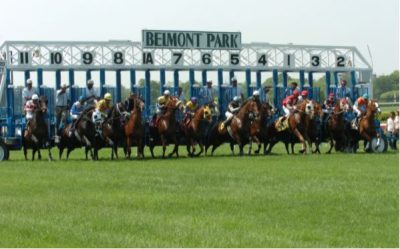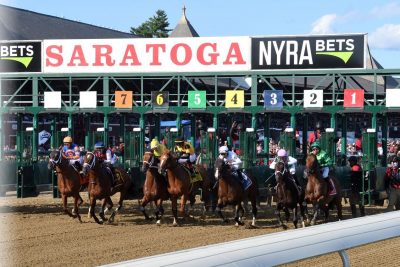By Noel Michaels
New York racing returns downstate for the Belmont Park Fall Championship Meet, which, as usual, offers top-notch racing from late summer to early fall. It’s also called the “Championship Meet” for good reason – Belmont runs the most important stakes races in just about every division leading up the 14-race, two-day Breeders’ Cup on Nov. 5-6.
The 28-day season opens Thursday, Sept. 16, following a 10-day break after the 40-day season at Saratoga. The Belmont meet runs through Oct. 31 – four days a week, Thursday-Sunday.
A total of 47 stakes are scheduled, including 20 graded stakes worth $11.5 million with four Grade 1’s and five Breeders’ Cup “Win and You’re In” races.
For the average horseplayer, Belmont can be a much easier meet to win at than Saratoga because field size is usually than at the Spa, especially on dirt.
Most of the horses running at the meet will be exiting starts at Saratoga. When evaluating form from Saratoga when horses show up again at Belmont, you can learn from trends at the recent meet.
Here goes:
Belmont dirt trends

Belmont Park – Photo Courtesy of NYRA
Belmont runs almost exclusively one-turn races on dirt at all distances, ranging from 5 furlongs to 9 furlongs. Belmont Park 1 1/4-mile races and 1 1/2-mile dirt races are rare (there’s the Belmont Stakes, of course), therefore a horse’s two-turn record is not important as its one-turn record. Also, with almost no two-turn races, there is little or no advantage to be gained by “saving ground” at Belmont on the main track. Gathering and maintaining momentum is more important, even if it is on the outside.
In terms of running styles, always assume the prevailing main track bias at Belmont will favor speed horses and front runner or pressers. The preferred running style favors horses able to stay within 2 1/2 lengths of the early pace in sprints, and within four lengths of the early pace in routes.
Races at 6 furlongs and shorter are most likely to favor inside posts at Belmont, with a slight preference to inside posts also at 6 ½ furlongs, too. That advantage tends to diminish beyond that.
Of course, nothing beats a good old horse-for-the-course. Belmont’s main track, “Big Sandy,” is a dramatically different surface from those at the Spa and Aqueduct. Certain horses love the Belmont dirt surface and others cannot do their best running there. Part of this preference has to do with the track surface, and some has to do with the track layout with Belmont’s wide sweeping turns and one-turn routes helping some and hurting others.
Saratoga-to-Belmont dirt angles

Saratoga – Photo Courtesy of Chelsea Durand
Evaluating returning-to-town talent is one of the keys to handicapping the fall meet. Many of the best horses will be returning from Saratoga, but they don’t always win. Plus, certain horses that lost at Saratoga will better bets at Belmont.
One of the reasons for Saratoga-to-Belmont form reversals is that horses with the best form at the Spa were excelling due to a preference for two-turn dirt races. This flip-flops at Belmont and instead favors one-turn horses who like the routes at Belmont. Also, horses better at 1 mile and 1 1/16 miles have better chances against those who liked the 1 1/8-mile dirt routes at the Spa.
Because of the track layout at the Spa, there were no 1-mile or 1 1/16-mile races on dirt. Most route races were run at 1 1/8 miles. This creates problems for horses who are best at a mile or 1 1/16 miles. These horses must stretch put to 1 1/8 miles or cut back to 7 furlongs.
Belmont turf trends
The inner and outer turf courses are big, wide, fair, and feature long stretch runs. Outside turf posts are a concern between 1 mile and 1 1/8 miles, but less so at other distances. Horses breaking from the far outside in 1-mile races and 1 1/16-mile races can be most negatively affected by outside posts.
Horses drawn in the inside four posts win at the best percentages in routes on both Belmont turf courses. Downgrade horses drawn in posts 8-12 at a 1 mile on the Widener turf course, and downgrade horses drawn 9-12 at 1 1/16 miles on the Widener.
On the inner turf, downgrade horses from posts 8 and outward in races at 1 1/16 miles and 1 1/8 miles.
Belmont’s 6-furlong and 7-furlong turf sprints are a different ballgame than at the Spa. Speed horses that were successful in Saratoga’s 5 ½ furlong turf sprints often underperform at Belmont at low prices. Closers and stalkers and pace-pressers, meanwhile, have an opportunity to do better at Belmont, especially if they draw post positions toward the outside. These horses didn’t have enough real estate to work with at Saratoga. Also, many runners who found 1 mile at Saratoga too far will get the chance to turn things around at 7 furlongs.
Turf sprint post positions are important, too. The inside turf sprint posts are tough at Saratoga, and outside draws are advantageous. Bet horses that lost from the Saratoga turf sprint rail post when they run back at Belmont.
When it rains, the inner turf typically dries out faster than the outer course, so always try to keep that in mind when evaluating horses that prefer good, yielding, or soft turf.
Saratoga-to-Belmont turf angles
When you see horses exiting turf losses on either course at Saratoga from posts 10-12, upgrade that horse at Belmont if it draws a better post. Horses from posts 10-12 at Saratoga were a combined 0-for-33. If you take it further, all the turf route posts 8 and outward had terrible seasons at Saratoga, going a combined 3-for-72 (4%).
There is also a Belmont handicapping angle for horses exiting inner turf course races at Saratoga. It doesn’t involve post positions, but rather, running style. The inner turf carries speed under firm conditions. These horses come back in droves to Belmont and provide a betting angle each fall. When you see horses at Belmont who won or ran big with front-running efforts on Saratoga’s inner turf, perhaps you can downgrade those horses because their running style probably had an advantage last time.
Conversely, when you see a horse exiting a Saratoga loss or sub-par effort on the inner turf at the Spa with a late-closing running style, you can upgrade them at Belmont. Remember, this angle is for horses exiting Saratoga inner turf races on firm turf only.

Noel Michaels has been involved in many aspects of thoroughbred racing for more than two decades, as a Breeders’ Cup-winning owner and as a writer, author, handicapper, editor, manager and promoter of the sport for a wide range of companies including Daily Racing Form and Nassau County Off-Track Betting.
He also is regarded as the leading source of news and information for handicapping tournaments and the author of the “Handicapping Contest Handbook: A Horseplayer’s Guide to Handicapping Tournaments”, which made his name virtually synonymous with the increasingly-popular tournament scene.
In addition to contributing to US Racing, he is also an analyst on the Arlington Park broadcast team.


